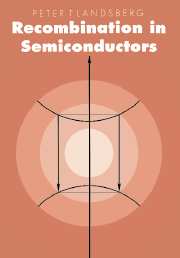Book contents
- Frontmatter
- Contents
- List of main symbols
- Note on units
- Introduction
- 1 Semiconductor statistics
- 2 Recombination statistics
- 3 Auger effects and impact ionization (mainly for bands)
- 4 Radiative recombination (mainly for bands)
- 5 Defects
- 6 Multiphonon recombination
- 7 Recombination in low-dimensional semiconductor structures
- Appendix A The delta function (section 3.2)
- Appendix B Useful identities arising from the periodic boundary condition (section 3.4)
- Appendix C Fourier expansions (section 3.4)
- Appendix D The effective mass sum rule and the dynamics of Bloch electrons (section 3.6)
- Appendix E Diagonalization and Jacobian for the threshold energy and impact ionization calculation (section 3.5.7)
- Appendix F The saddle-point method, and the method of stationary phase (section 6.3)
- Appendix G Evaluation of the integral (6.6.12) (section 6.6)
- References
- Index of names
- Index of topics, concepts and materials
4 - Radiative recombination (mainly for bands)
Published online by Cambridge University Press: 22 September 2009
- Frontmatter
- Contents
- List of main symbols
- Note on units
- Introduction
- 1 Semiconductor statistics
- 2 Recombination statistics
- 3 Auger effects and impact ionization (mainly for bands)
- 4 Radiative recombination (mainly for bands)
- 5 Defects
- 6 Multiphonon recombination
- 7 Recombination in low-dimensional semiconductor structures
- Appendix A The delta function (section 3.2)
- Appendix B Useful identities arising from the periodic boundary condition (section 3.4)
- Appendix C Fourier expansions (section 3.4)
- Appendix D The effective mass sum rule and the dynamics of Bloch electrons (section 3.6)
- Appendix E Diagonalization and Jacobian for the threshold energy and impact ionization calculation (section 3.5.7)
- Appendix F The saddle-point method, and the method of stationary phase (section 6.3)
- Appendix G Evaluation of the integral (6.6.12) (section 6.6)
- References
- Index of names
- Index of topics, concepts and materials
Summary
Introduction
After a brief review of the statistics of radiative recombination which introduces the transition probability per unit time per unit volume (BIJ) and stimulated and spontaneous emission in section 4.2, these concepts are derived quantum mechanically by second quantization in section 4.3. However, a reader willing to accept eq. (4.4.1) can skip that section. Next, emission rates as well as optical band-band absorption phenomena are discussed in sections 4.4 and 4.5. The simple relationships which exist by virtue of detailed balance between emission and absorption make theory and experiment on absorption relevant to emission problems. The emphasis on absorption depends on the fact that in a semiconductor under normal conditions the conduction band states are occupied with a probability less than unity, typically following a Boltzmann distribution exp (— E/kT). There are therefore comparatively few initial states for radiative emission from a band, and their number drops rapidly as E increases. In absorption these states are all available and one can also sample higher lying states where band structure effects, e.g. nonparabolicity, may play a part. The importance of absorption is due to the fact that it is often experimentally more accessible than emission studies.
Both emission and absorption are affected by the crucial difference between direct and indirect semiconductors.
- Type
- Chapter
- Information
- Recombination in Semiconductors , pp. 312 - 368Publisher: Cambridge University PressPrint publication year: 1992

